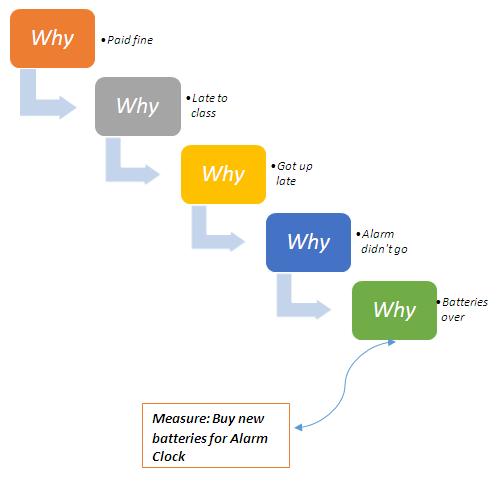- Business Concepts ›
- Operations and Supply Chain ›
- 5 Whys
5 Whys
Definition & Meaning
This article covers meaning & overview of 5 Whys from operations perspective.
What is meant by 5 Whys?
5 Whys is a problem solving technique where repetitive questions are asked to find out the root cause of the problem. This was first used by Toyota production system in 1970s. It is a simple method in analyzing problem and doesn’t requires any hypothesis data, regression and statistical tools etc.
Benefits of 5 whys
- Quickly determines the root cause of the problem
- No additional costs are incurred under its usage
- Helps in determining relationship between various problem causes
- Simple, easy and doesn’t require any regression or statistical tools like 6 sigma
5 Whys technique is most useful in day to day life (Things involving human interactions or factors) which doesn’t require any statistical tools to analyze. There are two techniques to perform 5 whys:
- Fishbone Diagram (or Ishikawa)
- Tabular Format
Steps to use 5 whys:
- First assemble all domain related personnel to discuss the problem
- Write down the problem and try to comprehend the situation
- Ask “Why” to personnel and jot down the answer
- If root cause is not found, repeat steps 3 and 4
- 5. If root cause is found, come to collective decision and attempt for a resolution
Below flow chart pictorially explains 5 whys with a simple example:

This article has been researched & authored by the Business Concepts Team which comprises of MBA students, management professionals, and industry experts. It has been reviewed & published by the MBA Skool Team. The content on MBA Skool has been created for educational & academic purpose only.
Browse the definition and meaning of more similar terms. The Management Dictionary covers over 1800 business concepts from 5 categories.
Continue Reading:
What is MBA Skool?About Us
MBA Skool is a Knowledge Resource for Management Students, Aspirants & Professionals.
Business Courses
Quizzes & Skills
Quizzes test your expertise in business and Skill tests evaluate your management traits
Related Content
All Business Sections
Write for Us